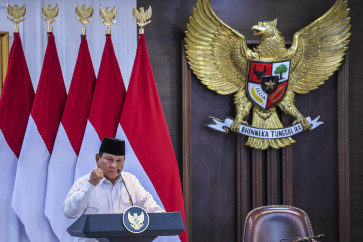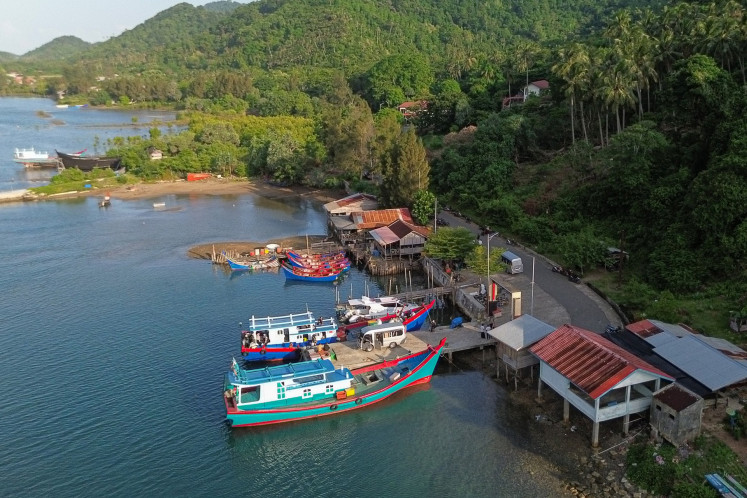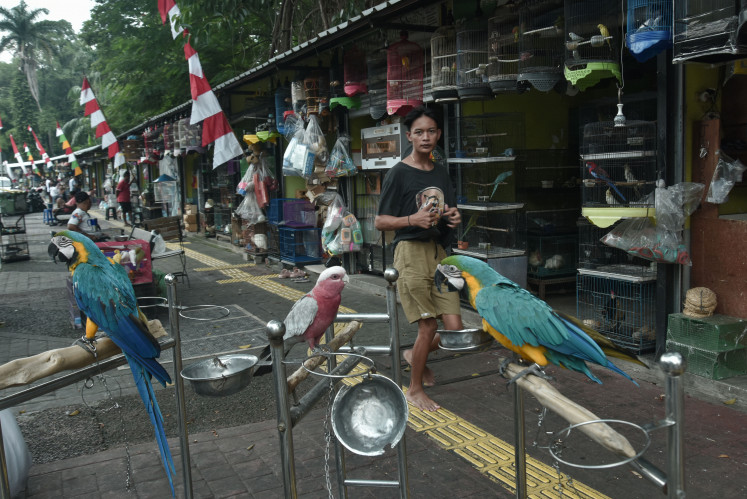Popular Reads
Top Results
Can't find what you're looking for?
View all search resultsPopular Reads
Top Results
Can't find what you're looking for?
View all search resultsHistory, legend of Komodo Island
Catching rays: Komodo dragons bathe in the sun at the national park on Komodo Island, East Nusa Tenggara
Change text size
Gift Premium Articles
to Anyone
Catching rays: Komodo dragons bathe in the sun at the national park on Komodo Island, East Nusa Tenggara.(JP/Markus Makur)
Komodo Island, located in eastern Indonesia, has become an asset of national pride as one of the New Seven Wonders of Nature and at the same time the habitat of a rare reptile that has survived since ancient times, the Komodo dragon.
Komodo dragons, scientifically named Varanus komodoensis, are a lizard species found only in East Nusa Tenggara, specifically on the islands of Komodo, Rinca, Flores, Gili Motang and Gili Dasami. Locals often call the lizard Ora.
A member of the Varanidae family and Toxicofera clade, the Komodo dragon is the world’s largest lizard at an average length of 2-3 meters. The huge size has to do with the phenomenon of island gigantism, in which certain animals on small islands tend to be gigantic due to the absence of carnivorous mammals and as a result of their slow metabolism.
With their huge proportions, these lizards occupy the top position of the food chain where they live. The Komodo’s habitat has been shrinking, which is why the International Union for Conservation of Nature (IUCN) has listed the Komodo dragon as a species vulnerable to extinction. The giant reptile is now protected under an Indonesian government regulation, and a national park has been established as a safe haven for the animal.
In fact, Komodo dragons are not the only appeal of the Komodo National Park (TNK). The website of the Environment and Forestry Ministry, which manages the park, also advertises the savanna and undersea scenery of the TNK as tourist attractions. Visitors have the choice of angling, snorkeling, diving, canoeing and boating in island waters. On land, nature tourism offers animal watching, hiking and camping.
Komodo lizards on Komodo Island were discovered around 1910 by a Dutch citizen. While hunting on the island, he encountered the giant reptiles by accident and documented them through photographs.
The photos were published at the Bogor Museum of Zoology, and in 1912, the document was widely publicized overseas. Before long, news about the existence of the huge lizards was circulating around the globe.
Scientists from many parts of the world came to the island to conduct research. Below are chronological records quoted from Loh Liang (a major TNK destination) about Komodo dragons on the island
* 1910: Discovery of Komodo dragons by J. K. H van Steyn
* 1912: Scientific naming (Varanus Komodoensis) by P. A. Owens
* 1912: Decision to protect Komodo dragon by sultan of Bima
* 1926: Protection of Komodo dragon by the Manggarai administration
* 1930: Protection of Komodo dragon by the regional head of Flores
* 1931: Listing of Komodo dragon as species to be absolutely protected in Wildlife Protection Law
* 1938: Establishment of Rinca Island and Padar Island Wildlife Reserve
* 1965: Establishment of Komodo Island Wildlife Reserve
* 1980: Establishment of Komodo National Park
* 1991: Komodo National Park made UNESCO World Heritage Site
* 1992: Declaration of Komodo dragon as national wildlife species by Presidential Decree No. 4/1992
* 2013: Declaration of Komodo National Park as one of the New Seven World Wonders of Nature
Not only scientific history is recorded in Loh Liang, visitors can also learn about local folklore and legends about the Komodo dragon. One of those stories can be read on a banner put up on the island:
“Once upon a time there lived a woman called Lady Naga on an island. The woman was married to a man from another region named Moja.
Thereafter, the lady conceived and gave birth to twin baby boys, but the twins were of different physical form. One was a human and the other took on the form of a lizard. This embarrassed Lady Naga and Moja.
Later the baby in lizard form, named Orah, was set out in a forest on another island, while the human baby was taken care of and named Gerong.
As time went by Gerong grew into an agile and courageous youngster. One day, when Gerong was going to hunt deer in a forest, he came across a giant lizard.
Gerong was chasing the huge lizard, eager to kill it with a spear. Suddenly, Lady Naga emerged and prevented Gerong from taking aim at the giant reptile.
Lady Naga told Gerong that the giant lizard was a Komodo dragon, and the twin sibling of Gerong. Following the incident, the locals treated the dragon decently.”
Komodo dragons live in the forest by hunting other animals such as deer, goats or boars. These giant lizards also live alongside the local community on Komodo Island up to this day.
Before the 1970s, Komodo islanders grew crops like corn, papaya, water melon, cassava and gourd. Traces of their plantations can still be found in Loh Liang, Komodo Island, Sebita and Loh Lawi. The activity was discontinued in 1975, when Komodo Island was made a biosphere reserve and national park.
Today, the significant development of ecotourism at the Komodo National Park gives residents a wide range of options for their livelihood. Many of them craft Komodo dragon figurines, others sell souvenirs or provide tourism services like cruises and home-stay accommodation and yet others make a living as tour guides.










